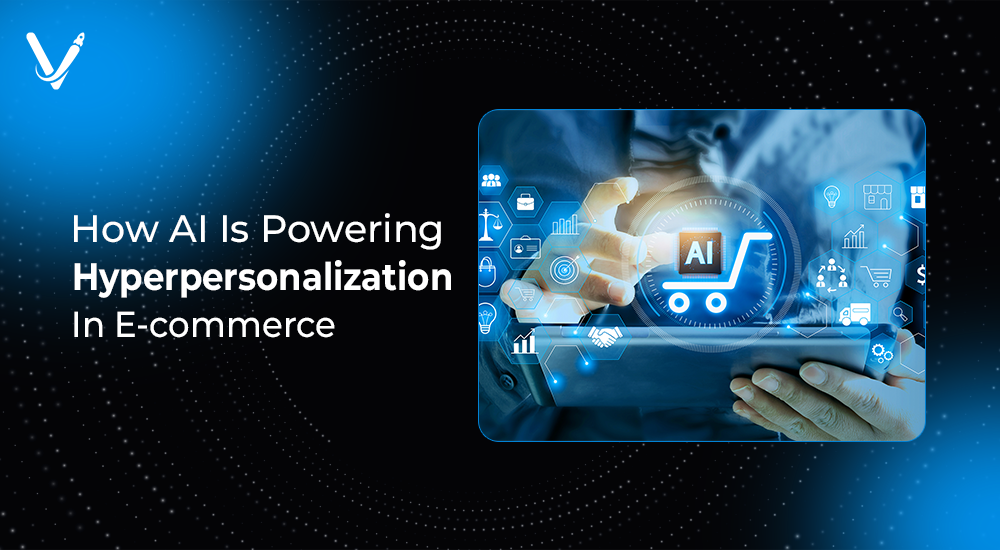How AI Is Powering Hyperpersonalization in E-commerce


- Jul 19, 2025
E-commerce has evolved. Shoppers no longer settle for generic storefronts or one-size-fits-all promotions. They expect every interaction—be it product suggestions, emails, or even pop-ups—to reflect their preferences, behaviors, and intent. Welcome to the age of hyper personalization, where the shopping experience feels tailor-made. And driving this revolution is AI-powered E-commerce personalization.
By combining predictive analytics, data collection, and artificial intelligence in e-commerce, businesses now understand their customers at an astonishing depth. The results? Increased conversions, stronger brand loyalty, and higher lifetime value. In this blog, we'll explore how AI-driven personalization is transforming e-commerce, what tools power this shift, and how your business can embrace it.
Traditional personalization is limited to basics: greeting a user by name, showing recently viewed items, or sending an email based on past purchases. Hyper personalization, on the other hand, uses AI-powered personalization to dynamically tailor every customer touchpoint using real-time behavioral data, preferences, browsing patterns, and even sentiment.
E-commerce platforms now track user behavior in real-time—clicks, scrolls, time on page, cart additions, and more. AI personalization tools ingest this behavioral data and update the user profile dynamically, allowing the system to tailor the user journey on the fly.
Arguably the most visible form of AI personalization in e-commerce, recommendation engines analyze:
This results in contextual, relevant product suggestions—not just what’s popular, but what’s personally compelling.
AI models identify patterns that the human eye would miss. With predictive analytics, systems can:
Forget traditional demographics. AI-powered personalization segments users based on micro-behaviors. For example:
This segmentation is dynamic and self-updating.
Artificial intelligence in e-commerce also enhances on-site search. NLP enables shoppers to search like they talk—"black shoes for party under ₹2000"—and the engine interprets this intent accurately.
Amazon uses AI for everything—from product recommendations to personalized pricing and targeted marketing. Its “Customers who bought this also bought…” feature alone generates nearly 35% of its revenue.
Using AI-powered ecommerce tools, Sephora customizes its website and app based on past product preferences, shade matching, and even beauty quiz results. Its chatbot, powered by AI, suggests products tailored to the customer’s skin type, color preference, and weather.
Though not typical e-commerce, Spotify and Netflix have trained users to expect AI-driven personalization. These platforms refine recommendations in real time using consumption patterns—something every ecommerce software development company should take note of.
ML models ingest vast data—clicks, purchases, likes, time on site—and learn which content leads to conversions. Over time, they get better at predicting preferences.
Used for chatbots, product search, customer feedback analysis, and smart filters, NLP helps personalize textual interactions in a human-like manner.
Fashion retailers use AI-powered ecommerce platforms to allow users to upload images and get style recommendations using visual recognition AI.
This technique continuously tests and optimizes the user journey by learning which actions lead to better outcomes—such as longer sessions or higher cart values.
Every user sees a version of the homepage that matches their behavior and preferences—new users get onboarding flows, while return visitors see abandoned cart items or new arrivals.
Gone are the days of batch emails. AI personalization tools automate hyper-targeted emails based on:
Push notifications are also dynamically crafted and timed for maximum impact.
AI chatbots do more than answer questions—they upsell, offer coupon codes, and recommend products. These bots improve customer retention while reducing human support costs.
Personalized recommendations increase conversion rates by 26% on average. Showing the right product at the right time drives spontaneous purchases and cross-sells.
Hyper personalization improves user satisfaction, leading to repeat purchases and brand loyalty.
Personalized incentives (like targeted coupons or urgent reminders) significantly reduce drop-offs.
Targeted campaigns reduce CAC (customer acquisition cost) by focusing only on high-intent prospects, thus maximizing return on ad spend (ROAS).
If you're exploring AI personalization ecommerce tools, start with:
Many of these tools can be integrated into popular e-commerce platforms like Shopify, Magento, WooCommerce, and custom-built systems.
Choose platforms or an AI development company that allows you to plug AI models into various touchpoints—search, recommendation, pricing, content.
Quality personalization relies on quality data. Collect, clean, and enrich customer data via:
Work with a team experienced in ecommerce personalization using AI. They can help you:
As AI voice assistants grow smarter, expect users to start purchasing through voice—asking for personalized deals, product suggestions, or order updates.
AI will not just react—it will predict. Storefronts will morph based on what users will want, not what they’ve done.
Retailers will use AI to create personalized learning AI journeys that educate customers about products, use cases, or bundles based on their interests.
AI will fine-tune pricing based on user intent, time of day, supply-demand balance, and even user mood (based on sentiment analysis).
Choosing the right AI development company is key to unlocking hyper personalization. A specialized firm can help you:
A trusted ecommerce software development company will not just build features but co-create outcomes aligned with your growth goals.
Hyper personalization is the new currency of customer experience. Businesses that invest in AI-powered personalization will reap higher engagement, loyalty, and sales. Meanwhile, those who don’t risk being forgotten in a sea of generic stores.
Whether you're an established brand or a fast-growing D2C startup, partnering with the right AI development company is the first step to reshaping your customer journey.
At Vasundhara Infotech, we specialize in building intelligent, scalable, and privacy-first AI systems for modern e-commerce platforms. Let us help you redefine what your customers expect—and exceed it.
Copyright © 2026 Vasundhara Infotech. All Rights Reserved.
